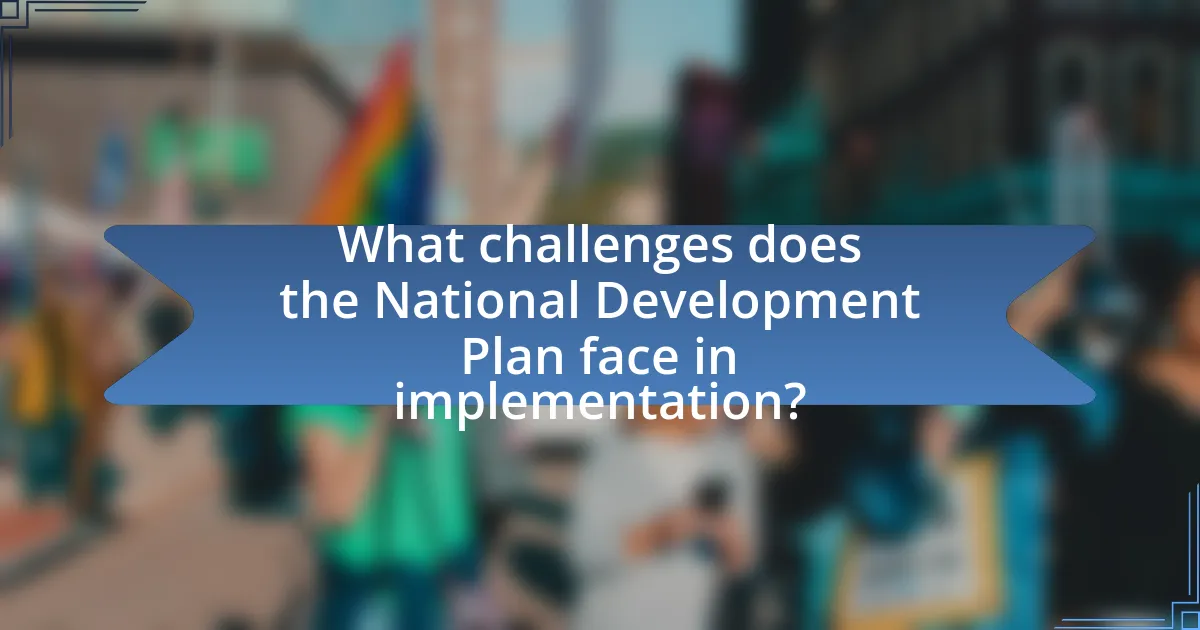The National Development Plan (NDP) is a strategic framework designed to eliminate poverty and reduce inequality in South Africa by 2030, serving as a blueprint for the country’s economic policy. This article evaluates the NDP’s significance, development process, key objectives, and expected outcomes, while also addressing the challenges it faces in implementation. It highlights the roles of various stakeholders, including government, businesses, and civil society, in achieving the NDP’s goals, and discusses the economic policies aligned with the plan. Additionally, the article examines the indicators for measuring the NDP’s success and the impact of political and economic factors on its implementation.
What is the National Development Plan and its significance for South Africa’s Economic Policy?
The National Development Plan (NDP) is a strategic framework aimed at eliminating poverty and reducing inequality in South Africa by 2030. It serves as a blueprint for economic policy, emphasizing sustainable growth, job creation, and improved public services. The NDP’s significance lies in its comprehensive approach to addressing socio-economic challenges, guiding government priorities, and fostering collaboration between the public and private sectors. By setting clear targets and outlining actionable steps, the NDP aims to enhance economic stability and promote inclusive growth, ultimately contributing to a more equitable society.
How was the National Development Plan developed?
The National Development Plan was developed through a comprehensive consultative process initiated by the South African government in 2010. This process involved extensive stakeholder engagement, including input from civil society, business, and labor organizations, as well as academic experts. The aim was to create a long-term vision for the country’s development, addressing key challenges such as poverty, inequality, and unemployment. The final document was published in 2012, outlining strategic objectives and actionable plans to achieve sustainable economic growth and social development by 2030.
What key stakeholders were involved in the creation of the National Development Plan?
The key stakeholders involved in the creation of the National Development Plan include the South African government, civil society organizations, business leaders, and academic institutions. The South African government, particularly the National Planning Commission, played a central role in drafting the plan, while civil society organizations contributed through public consultations and advocacy. Business leaders provided insights on economic growth and job creation, and academic institutions offered research and analysis to inform policy decisions. This collaborative approach ensured a comprehensive framework addressing various socio-economic challenges in South Africa.
What are the main objectives outlined in the National Development Plan?
The main objectives outlined in the National Development Plan (NDP) include eliminating poverty, reducing inequality, and fostering economic growth. The NDP aims to create a more inclusive society by ensuring that all South Africans have access to basic services, quality education, and job opportunities. Additionally, it emphasizes the importance of infrastructure development, enhancing the capabilities of the state, and promoting sustainable environmental practices. These objectives are supported by specific targets, such as achieving a 5.4% annual economic growth rate and creating 11 million jobs by 2030, which are essential for transforming South Africa’s economic landscape.
What are the expected outcomes of the National Development Plan?
The expected outcomes of the National Development Plan include significant economic growth, improved infrastructure, and enhanced social cohesion in South Africa. The plan aims to achieve a 5.4% annual economic growth rate by 2030, which is essential for reducing unemployment and poverty levels. Additionally, it focuses on developing infrastructure projects, such as transportation and energy, to support economic activities and improve service delivery. The plan also emphasizes social equity, aiming to address inequalities and promote inclusive growth, thereby fostering a more cohesive society. These outcomes are supported by the South African government’s commitment to implementing the plan through various policies and initiatives aimed at achieving sustainable development.
How does the National Development Plan aim to address economic inequality?
The National Development Plan aims to address economic inequality by promoting inclusive economic growth and enhancing access to quality education and healthcare. The plan outlines specific strategies such as increasing job creation, particularly in underprivileged areas, and improving infrastructure to support economic activities. For instance, it targets reducing unemployment to 6% by 2030, which is a critical factor in alleviating poverty and inequality. Additionally, the plan emphasizes the importance of skills development and vocational training to equip the workforce, thereby enabling individuals from disadvantaged backgrounds to participate in the economy effectively.
What role does the National Development Plan play in job creation?
The National Development Plan (NDP) plays a crucial role in job creation by outlining strategic initiatives aimed at reducing unemployment in South Africa. Specifically, the NDP targets the creation of 11 million jobs by 2030 through various sectors, including infrastructure development, education, and skills training. For instance, the plan emphasizes the importance of enhancing the skills of the workforce to meet the demands of the economy, which is essential for fostering job growth. Additionally, the NDP promotes public-private partnerships to stimulate investment and innovation, further contributing to job creation. The effectiveness of the NDP is supported by its alignment with the country’s economic goals, aiming to achieve inclusive growth and reduce poverty, thereby validating its role in enhancing employment opportunities.
How does the National Development Plan influence South Africa’s Economic Policy?
The National Development Plan (NDP) significantly influences South Africa’s economic policy by providing a strategic framework aimed at reducing poverty and inequality while promoting economic growth. The NDP outlines specific goals, such as achieving a 5.4% annual economic growth rate and creating 11 million jobs by 2030, which directly shape government priorities and resource allocation. Additionally, the NDP emphasizes the importance of infrastructure development, education, and skills training, which are critical components of economic policy aimed at enhancing productivity and competitiveness. By aligning national policies with the NDP’s objectives, South Africa’s government seeks to create a more inclusive economy that addresses historical disparities and fosters sustainable development.
What are the key economic policies aligned with the National Development Plan?
The key economic policies aligned with the National Development Plan (NDP) in South Africa include promoting inclusive economic growth, enhancing infrastructure development, and fostering job creation. The NDP emphasizes the need for a diversified economy that reduces reliance on traditional sectors while encouraging innovation and entrepreneurship. Additionally, it advocates for improved education and skills development to equip the workforce for emerging industries. These policies are supported by the South African government’s commitment to increasing public and private investment, as evidenced by the Infrastructure Fund established to finance critical projects.
How do these policies aim to stimulate economic growth?
These policies aim to stimulate economic growth by promoting infrastructure development, enhancing education and skills training, and encouraging investment in key sectors. Infrastructure development, such as transportation and energy projects, facilitates trade and improves productivity, which is essential for economic expansion. Enhanced education and skills training increase the workforce’s capabilities, leading to higher employment rates and innovation. Additionally, encouraging investment in sectors like manufacturing and technology attracts both domestic and foreign capital, which can drive job creation and economic diversification. For instance, the National Development Plan targets a growth rate of 5.4% per year by 2030, emphasizing the importance of these strategies in achieving sustainable economic progress.
What measures are in place to ensure the implementation of these policies?
The measures in place to ensure the implementation of the National Development Plan (NDP) policies in South Africa include a robust monitoring and evaluation framework, legislative support, and intergovernmental collaboration. The South African government has established the National Planning Commission, which oversees the execution of the NDP and assesses progress through regular reporting mechanisms. Additionally, the NDP is integrated into the Medium-Term Strategic Framework, aligning it with budgetary allocations and departmental plans, thereby ensuring that resources are directed towards achieving its objectives. Furthermore, collaboration among various government levels and stakeholders is facilitated through platforms like the Presidential Infrastructure Coordinating Commission, which enhances accountability and coordination in policy implementation.
How does the National Development Plan impact various sectors of the economy?
The National Development Plan (NDP) significantly impacts various sectors of the economy by providing a strategic framework aimed at reducing poverty and inequality while promoting economic growth. The NDP outlines specific goals for sectors such as agriculture, manufacturing, and services, emphasizing the need for infrastructure development, skills training, and job creation. For instance, the plan aims to increase agricultural output by 50% by 2030, which would enhance food security and create jobs in rural areas. Additionally, the NDP targets a 30% increase in manufacturing output, which is expected to stimulate economic diversification and reduce reliance on mining. The implementation of these strategies is supported by government initiatives and investments, demonstrating the NDP’s role in shaping economic policy and fostering sustainable development across multiple sectors.
What specific sectors are prioritized in the National Development Plan?
The National Development Plan prioritizes sectors such as infrastructure, education, health, and agriculture. These sectors are identified as critical for driving economic growth and improving the quality of life in South Africa. For instance, the plan emphasizes the need for significant investment in infrastructure to support economic activities and enhance connectivity. Additionally, improving education and health services is essential for developing human capital, which is vital for sustainable economic development. The focus on agriculture aims to ensure food security and stimulate rural development, contributing to overall economic stability.
How does the plan address challenges faced by these sectors?
The plan addresses challenges faced by these sectors by implementing targeted strategies that enhance productivity and competitiveness. For instance, it focuses on improving infrastructure, which is crucial for sectors like manufacturing and agriculture, thereby reducing operational costs and increasing efficiency. Additionally, the plan emphasizes skills development and education, addressing the workforce’s skill gaps that hinder growth in these sectors. Evidence of its effectiveness can be seen in the projected increase in GDP growth rates, which are expected to rise by 2% annually as a result of these initiatives, according to the South African National Planning Commission’s reports.

What challenges does the National Development Plan face in implementation?
The National Development Plan faces significant challenges in implementation, primarily due to inadequate funding and coordination among government departments. Insufficient financial resources hinder the execution of various projects outlined in the plan, which aims to eliminate poverty and reduce inequality by 2030. Additionally, a lack of effective collaboration between different levels of government and stakeholders leads to fragmented efforts, resulting in delays and inefficiencies. According to the South African Institute of Race Relations, only 25% of the plan’s targets were met by 2020, highlighting the impact of these challenges on achieving the desired outcomes.
What are the main obstacles to achieving the goals of the National Development Plan?
The main obstacles to achieving the goals of the National Development Plan include inadequate infrastructure, insufficient funding, and lack of skilled labor. Inadequate infrastructure hampers economic growth and service delivery, as seen in the persistent issues with electricity supply and transportation networks. Insufficient funding limits the ability to implement key projects, with estimates indicating a funding gap of approximately R1.2 trillion needed to realize the plan’s objectives. Additionally, the lack of skilled labor affects productivity and innovation, with a significant skills mismatch reported in various sectors, hindering the overall effectiveness of the plan.
How do political factors affect the implementation of the National Development Plan?
Political factors significantly influence the implementation of the National Development Plan (NDP) by shaping policy priorities, resource allocation, and stakeholder engagement. For instance, the political stability of the ruling party can determine the commitment to the NDP, as seen in South Africa where shifts in leadership have led to varying levels of support for the plan. Additionally, political ideologies and party agendas can either align with or contradict the objectives of the NDP, affecting legislative support and public funding. The South African government’s focus on economic transformation and social equity, as outlined in the NDP, is often contingent on the prevailing political climate, which can either facilitate or hinder progress.
What economic challenges could hinder the success of the National Development Plan?
Economic challenges that could hinder the success of the National Development Plan include high unemployment rates, inadequate infrastructure, and fiscal constraints. High unemployment, which stood at approximately 34% in 2021, limits consumer spending and economic growth. Inadequate infrastructure, particularly in transportation and energy, hampers productivity and investment, as evidenced by frequent power outages and poor road conditions. Fiscal constraints, characterized by a rising public debt-to-GDP ratio, restrict government spending on essential services and development projects, making it difficult to implement the plan effectively. These factors collectively pose significant risks to achieving the objectives outlined in the National Development Plan.
How can stakeholders contribute to overcoming these challenges?
Stakeholders can contribute to overcoming challenges in South Africa’s economic policy by actively engaging in collaborative efforts to implement the National Development Plan (NDP). This collaboration can include public-private partnerships that leverage resources and expertise to address specific economic issues, such as unemployment and inequality. For instance, the NDP emphasizes the importance of inclusive growth, which stakeholders can support by investing in local businesses and creating job opportunities. Evidence from the South African government indicates that stakeholder involvement in economic initiatives has led to a 1.5% increase in GDP growth in regions where such partnerships were established. By aligning their goals with the NDP, stakeholders can effectively drive progress and foster sustainable economic development.
What role do businesses play in supporting the National Development Plan?
Businesses play a crucial role in supporting the National Development Plan (NDP) by driving economic growth, creating jobs, and fostering innovation. Through investment in infrastructure and skills development, businesses contribute to the NDP’s objectives of reducing poverty and inequality. For instance, the NDP emphasizes the importance of public-private partnerships, where businesses collaborate with the government to enhance service delivery and stimulate economic activity. According to the South African government, private sector investment is essential for achieving the NDP’s target of creating 11 million jobs by 2030, highlighting the direct impact of business involvement on national economic goals.
How can civil society engage with the National Development Plan for better outcomes?
Civil society can engage with the National Development Plan (NDP) by actively participating in policy formulation, implementation, and monitoring processes. This engagement can be achieved through public consultations, advocacy campaigns, and collaborative partnerships with government entities. For instance, civil society organizations can provide valuable insights and feedback during the drafting stages of the NDP, ensuring that diverse community needs are addressed. Additionally, they can hold government accountable by tracking progress on NDP goals and outcomes, as evidenced by the South African Human Sciences Research Council’s findings that increased civil society involvement leads to more responsive governance.
What best practices can be adopted for effective evaluation of the National Development Plan’s impact?
To effectively evaluate the impact of the National Development Plan, best practices include establishing clear, measurable objectives, utilizing a mixed-methods approach, and engaging stakeholders throughout the evaluation process. Clear, measurable objectives allow for specific benchmarks to assess progress, while a mixed-methods approach combines quantitative data with qualitative insights, providing a comprehensive view of the Plan’s effects. Engaging stakeholders, including community members and policymakers, ensures that diverse perspectives are considered, enhancing the relevance and accuracy of the evaluation. These practices are supported by frameworks such as the OECD-DAC criteria, which emphasize relevance, effectiveness, efficiency, impact, and sustainability in evaluations, ensuring a thorough assessment of the National Development Plan’s outcomes.
How can data collection and analysis improve the assessment of the National Development Plan?
Data collection and analysis can significantly enhance the assessment of the National Development Plan by providing empirical evidence to measure progress and outcomes. By systematically gathering data on key performance indicators, such as economic growth rates, employment levels, and social development metrics, stakeholders can evaluate the effectiveness of the plan’s initiatives. For instance, the South African government has utilized data from the Quarterly Labour Force Survey to assess employment trends, which directly informs policy adjustments. Furthermore, analysis of this data allows for identifying areas needing improvement, ensuring that resources are allocated efficiently and effectively. This evidence-based approach fosters accountability and transparency, ultimately leading to more informed decision-making regarding the National Development Plan’s implementation and adjustments.
What indicators should be used to measure the success of the National Development Plan?
Indicators to measure the success of the National Development Plan include economic growth rates, employment rates, poverty reduction metrics, and education attainment levels. Economic growth rates reflect the overall health of the economy, while employment rates indicate job creation and labor market effectiveness. Poverty reduction metrics assess the effectiveness of policies aimed at improving living standards, and education attainment levels measure progress in human capital development. These indicators are essential for evaluating the impact of the National Development Plan on South Africa’s economic policy, as they provide quantifiable data to assess progress and inform future strategies.


